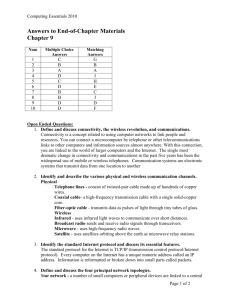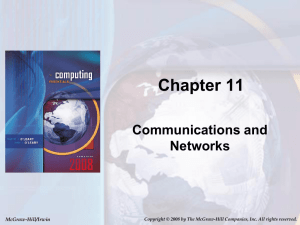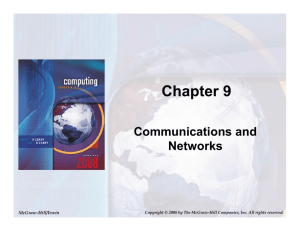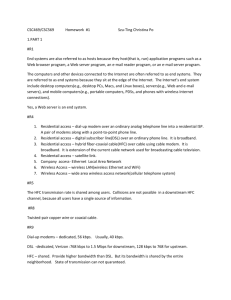chapter-8-ppt
advertisement
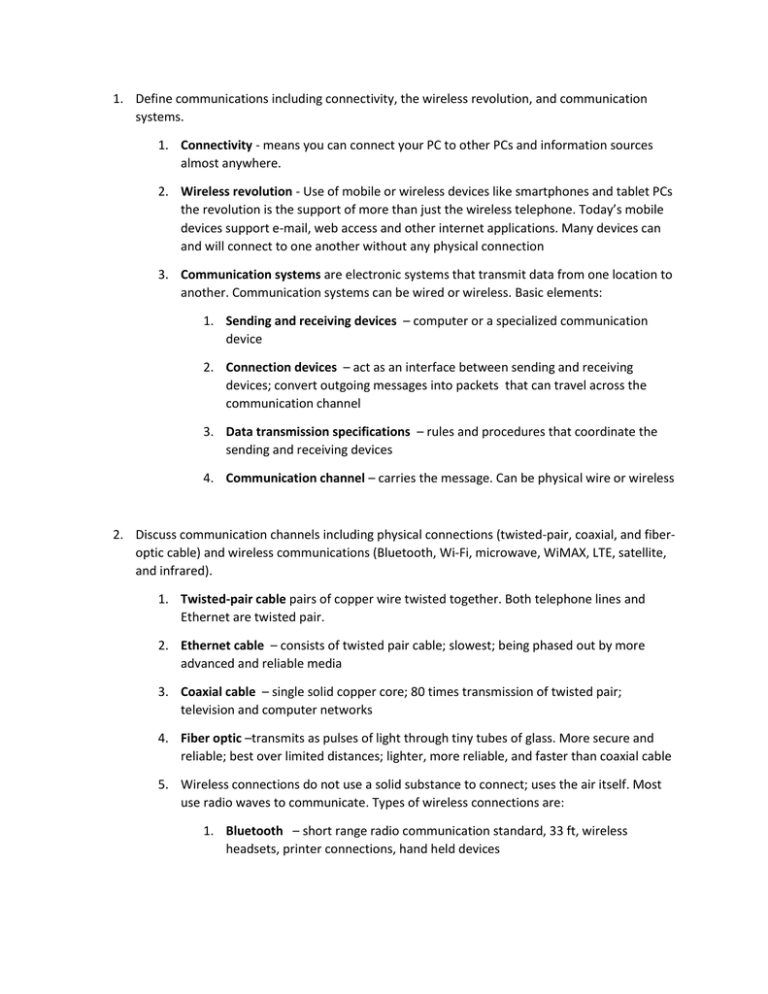
1. Define communications including connectivity, the wireless revolution, and communication systems. 1. Connectivity - means you can connect your PC to other PCs and information sources almost anywhere. 2. Wireless revolution - Use of mobile or wireless devices like smartphones and tablet PCs the revolution is the support of more than just the wireless telephone. Today’s mobile devices support e-mail, web access and other internet applications. Many devices can and will connect to one another without any physical connection 3. Communication systems are electronic systems that transmit data from one location to another. Communication systems can be wired or wireless. Basic elements: 1. Sending and receiving devices – computer or a specialized communication device 2. Connection devices – act as an interface between sending and receiving devices; convert outgoing messages into packets that can travel across the communication channel 3. Data transmission specifications – rules and procedures that coordinate the sending and receiving devices 4. Communication channel – carries the message. Can be physical wire or wireless 2. Discuss communication channels including physical connections (twisted-pair, coaxial, and fiberoptic cable) and wireless communications (Bluetooth, Wi-Fi, microwave, WiMAX, LTE, satellite, and infrared). 1. Twisted-pair cable pairs of copper wire twisted together. Both telephone lines and Ethernet are twisted pair. 2. Ethernet cable – consists of twisted pair cable; slowest; being phased out by more advanced and reliable media 3. Coaxial cable – single solid copper core; 80 times transmission of twisted pair; television and computer networks 4. Fiber optic –transmits as pulses of light through tiny tubes of glass. More secure and reliable; best over limited distances; lighter, more reliable, and faster than coaxial cable 5. Wireless connections do not use a solid substance to connect; uses the air itself. Most use radio waves to communicate. Types of wireless connections are: 1. Bluetooth – short range radio communication standard, 33 ft, wireless headsets, printer connections, hand held devices 2. WiFi – wireless Fidelity communicates over short distances. WiFi standards and speeds are shown in the table. 3. Microwave - Uses high-frequency radio waves 4. WiMax – Worldwide Interoperability for microwave Access – allows greater distances for Wi-Fi. 5. LTE (long term evolution) newest wireless standards. Similar to WiMax but promises to provide greater speed and quality in the near future 6. Satellite uses satellites orbiting about 22,000 miles above the earth as microwave relay stations; many of these offered by Intelsat, the International Telecommunications Satellite Consortium which is owned by 114 governments and forms a worldwide communications system 7. Uplink sending data to a satellite 8. Downlink receiving data from a satellite 9. GPS (Global Positioning system) use a network of 24 satellites owned and managed by the Defense Department which continuously sends location information to earth 10. Infrared - Light waves used over short distances. Sometimes called line of sight communications. Sending and receiving devices must be in clear view of one another 3. Discuss connection devices including modems (telephone, DSL, cable, and wireless modems) and connection services (DSL, ADSL, cable, satellite and cellular connection services). 1. Modem short for modulator-demodulator 2. Modulation – convert from digital to analog 3. Demodulation - convert from analog to digital 4. Transfer rate – rate in Mbps data transmits 1. Types of modems 5. Telephone 6. DSL (digital subscriber line) – uses standard phone lines to create a high speed connect. ASDL (asymmetric digital subscriber line) is one of the most widely used types of DSL 7. Cable - uses same coaxial cable as television 8. Wireless – also known as WWAN modem 2. Connection Types 3. T1, T2, and T3 leased lines – do not require conventional modems and provide very high capacity and is expensive. Being replaced by optical carrier (OC) lines 4. DSL – uses existing telephone lines to provide high-speed connections; uses DSL modems, ADSL – asymmetric digital subscriber line. Replaced dial-up services a. Cable – Cable connections reach 90% of homes in America 5. Satellite/air connection services – two-way satellites capable of handling both uploading and downloading; available almost anywhere but slower than DSL 6. Cellular services – option for mobile devices and laptops using 3G and 4G cellular networks 7. 1G started in the 1980s using analog radio signals 8. 2G started in the 1990s using digital radio signals 9. 3G started in the 2000s with the marketing of smartphones 10. 4G can use WiMax and LTE to provide faster transmissions. 10 times faster than 3G 4. Discuss data transmission including bandwidths (voice band, medium band, broadband, and baseband) as well as protocols (IP addresses, domain name servers, and packetization). 1. Bandwidth – measurement of the width or capacity of the communication channel. It means how much information can move across the communication channel in a given amount of time. 2. Four Types: 1. Voiceband – also known as low bandwidth ; standard phone line; too slow for many types of transmissions – especially high-quality video; typical speeds are 56 to 96 kbps 2. Medium band – with special leased lines to connect minicomputers and mainframes as well as to transmit data over long distances (for larger computer systems); not typically used by individuals 3. Broadband – used for high-capacity transmissions (DSL, cable, satellite connections); specialized high-speed devices; effectively transmits high-quality video and other communication needs; typically 1.5 mbps; higher speeds possible 4. Baseband – widely used to connect individual computers that are located close to one another 3. Protocols Rules for exchanging data between computers 4. HTTP – Hypertext Transfer Protocol 5. HTTPS – hypertext transfer protocol secure is becoming widely used to protect the transfer of sensitive information 6. TCP/IP - Internet Standard 7. Essential features of protocol 1. Identification - Identifying sending and receiving devices. Every computer on the Internet has a unique numeric address called an IP Address, Internet Protocol address 2. Domain Name Server (DNS) converts text-based addresses to IP addresses 3. Packetization – allows message to be broken into small parts called packets so easier to transmit over Internet through various interconnected networks; allows message to be reassembled at destination 5. Discuss networks by identifying and defining specialized terms that describe computer networks. 1. A computer network is a communication system that connects two or more computers so that they can exchange information and share resources Nodes any device connected to a network Client a node that requests and uses resources from other nodes Server a node that share resources with other nodes Directory server – specialized server that manages resources Host computer system that can be accessed over a network Router node that forwards or routes data packets Switch central node that coordinates the flow of data. These tasks used to be performed by a hub Network interface cards (NIC) expansion card that connects a computer to a network Network operating system (NOS) control activities of all computers on the network Network administrator computer specialists responsible for network operations 6. Discuss network types including local area, home, wireless, personal, metropolitan, and wide area networks. 1. Local area networks - LANs Computers and devices linked in distances of less than a mile. Linked by cable. Benefits are for economy and flexibility. With network gateways, LANs can be connected to other LANs or any other type of network. Ethernet is one standard for connecting network nodes together. 2. Home Networks – LANs are now being commonly used by individuals in home/apartments; allow different computers to share resources including a common Internet connection; can be connected by various means including a wireless LAN (WLAN) 3. Wireless LAN – wireless local area network. All communications pass through the network’s centrally located wireless access point or base station 4. Hotspot - is a wireless access point that is open to the public 5. Personal Area networks – works within a very small area. Connects cell phones to headsets, PDAs to other PDAs, keyboards to cell phones, etc. 6. MANs (metropolitan area network) –span distances up to 100 miles. Network linking nodes and resources within the geographical bounds of a city 7. WANs (wide area networks) - Countrywide and worldwide networks. Use microwave relays and satellites to reach users. Internet is the widest WAN 7. Define network architecture including topologies (bus, ring, star, tree, and mesh) and strategies (client/server and peer-to-peer). 1. Network Architecture - describes how a network is arranged and how resources are coordinated and shared 1. Bus network is where each device is connected to a common cable called a bus or a backbone 2. Ring Network all communications travel along a ring 3. Star network –All communications pass through the switch; each connecting device is asked (“polled”) whether it has a message to send and then each device is in turn allowed to send its message 4. Tree Network or hierarchical network - The central node is connected to two or more subordinate nodes that in turn are connected to other subordinate nodes. Useful in centralized organization 5. The mesh network is the newest type and does not use a specific physical layout. Does not use a specific physical layout, but requires that each node have more than one connection to other nodes. If a path between two nodes is disrupted, data can be rerouted around the failure using another path. Wireless technologies are frequently used to build mesh networks. 8. Discuss organization networks including Internet technologies (intranets and extranets) and network security (firewalls, proxy servers, intrusion detection systems, and virtual private networks). 1. Intranet (key term) private network within an organization 2. Extranet (key term) private network that connects more than one organization 3. Firewalls – Organizational firewalls include a proxy server (key term) all communications between the outside world and an organization must pass through the proxy server where the source and content of each communication is evaluated. 4. Intrusion detection systems (NIDS) - Uses advanced pattern matching and heuristics. Can recognize signs of a network attack and disable access before an intruder can do damage 5. Virtual private network (VPN) - Creates a secure private connection between a remote user and an organizations’ internal network. Creates the equivalent of a dedicated line between a user’s home or laptop computer and a company server
